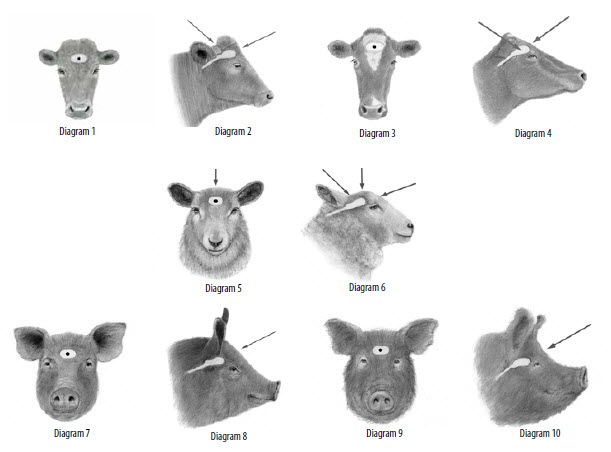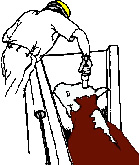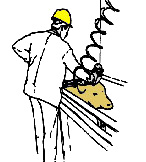

To produce instantaneous unconsciousness, the bolt must penetrate the brain with a high concussive impact. For cattle, the stunner is placed on the middle of the forehead on an "X" formed between the eyes and the base of the horns. Some plants place the stunner on the hollow behind the animal's poll on the back of the head. This position is less effective, therefore the frontal position on the forehead is recommended. One of the reasons the poll position is less effective is shooting at the correct angle is sometimes difficult. The shot must be aimed as shown in diagrams 2, 4, and 6. Shooting straight down is the nape of the neck will not reliably induce instantaneous insensibility (Lambooy and Spanjaard, 1981). Shooting in the nape of the neck does not penetrate the brain. There the frontal position is the primary position. Poll shooting should only be used in situations where it is difficult to get a good frontal shot. For example, when an animal puts it head down and the forehead cannot be reached.
The diagrams serve as a basic guide for shooting position. The ideal spot can vary depending on the breed of the animal and the shape of the skull. To train stunner operators, splitting heads with a band saw will show them the best location for reliably penetrating the brain. To obtain maximum bolt velocity, the captive bolt gun must be placed perpendicular to the skull. Angling the gun will result in less hitting power.
Due to concerns about BSE (Bovine Spongiform Encephalopathy) saving brains is not recommended. Brain and spinal cord tissue should be discarded and not used as food for either people or animals.
 |
Poor maintenance of cartridge fired captive bolt guns and pneumatic captive bolt guns is a major cause of stunner failure (Grandin, 1998). For sheep, a captive bolt is placed on the top of the head. This position is more effective for sheep because they have a very thick skull over the forehead. For pigs, the captive bolt is placed on the forehead. Diagram 6 shows two other positions that are effective for sheep. A good stunner operator learns not to chase the animal's head. Take the time and aim for one good shot. The stunner must be placed squarely on the animal's head. All equipment manufacturers' recommendations and instructions must be followed. Pneumatic stunners must have an adequate air supply. Low air pressure is one cause of poor stunning. |
 |
Damp cartridges can cause cartridge fired bolt gunes to fail (Grandin 2002, 2005). Soft sounding shots may be associated with poorer stunning (Grandin 2002, Lambooy and Spanjaard 2007). Damp cartridges are one cause of less powerful, soft sounding shots. Eye reflexes should be checked often to insure that stunning is making the cattle unconscious. When the eyelid or cornea is touched there should be no response. An animal that blinks is not properly stunned. Rythmic breathing should have stopped and there should be no indication of a righting reflex when the animal is hanging on the rail. Reflexes may cause a stunned animal's legs to move, but the head should hang straight down and be limp. See the section on insensibility for more information. |
Grandin, T. 2002. Return to sensibility problems after penetrating captive bolt stunning of cattle in commercial beef slaughter plants. Journal Am. Vet. Med. Assoc. 221: 1258-1261.
Grandin, T. 2005. Maintenance of good animal welfare standards in beef slaughter plants by use of auditing programs. Journal Am. Vet. Med. Assoc. 226:370-373.
Grandin, T. 2010. Recommended Animal Handling Guidelines and Audit Guides. Am. Meat. Institute. Washington, D.C.
Gregory, N. et al. 2007. Depth of concussion in cattle shot with penetrating captive bolt. Meat Science. 77:499-503.
Lambooy, E., and Spanjaard, W. 1981. Effect of shooting position on the stunning of calves by captive bolt. Vet. Record. 109:359-361.
 Click here to return to the Homepage for more information on animal behavior, welfare, and care.
Click here to return to the Homepage for more information on animal behavior, welfare, and care.
 Click here for more information on Animal Welfare and Humane Slaughter.
Click here for more information on Animal Welfare and Humane Slaughter.